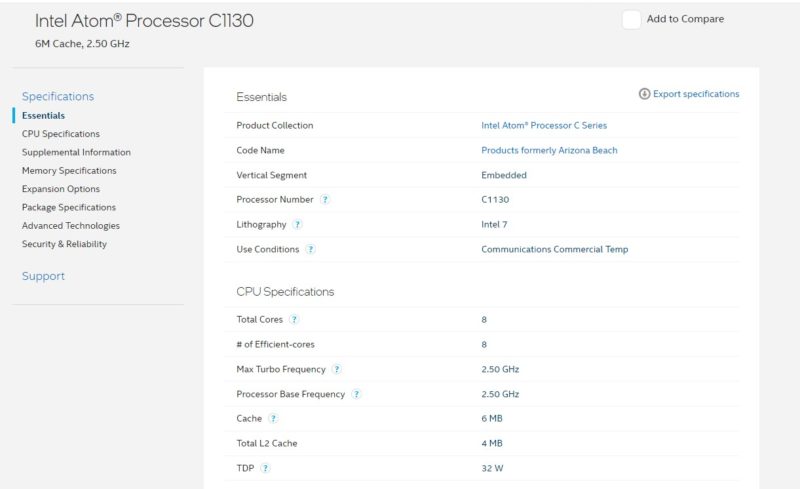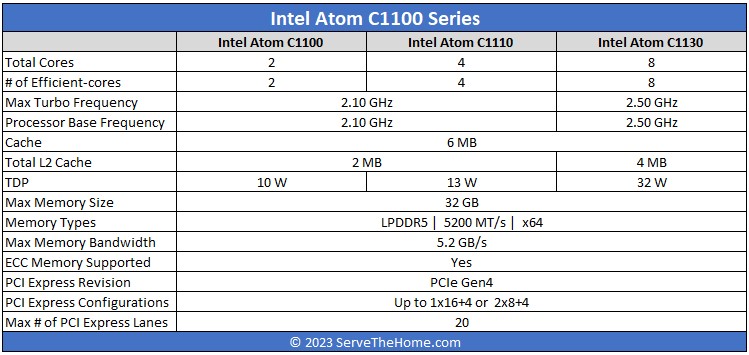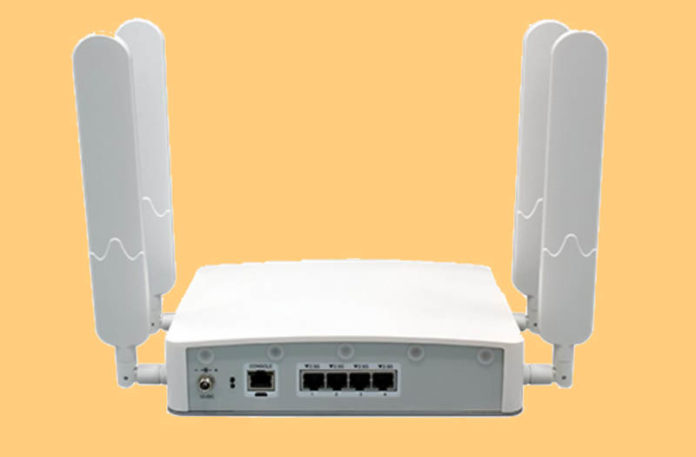Intel has been holding out on us. There are three “Arizona Beach” Atom SKUs that launched with little to no fanfare. We only spotted them based on a news tip sent in by a reader. The new Intel Atom C1100, C1110, and C1130 seem to be the newest SKUs on the market. At first glance, you may think that 2, 4, and 8 core chips are just a rebranded Alder Lake-N series E-core solution like the Fanless Intel N100 Firewall we just reviewed. These are not and have some really interesting features.
Intel Atom C1100 “Arizona Beach” Launched
In terms of specs, the Intel Atom C1130 is an Intel 7 part with a 2.5GHz base and turbo frequency. It has 6MB L3 cache and 4MB of L2 cache. There are a total of eight Intel E-cores. What is surprising is the TDP of 32W.

The specs viewed alongside the Atom C1100 and C1100 are more interesting. These chips apparently use dual-channel LPDDR5. They also have PCIe Gen4 in either 1x x16 + 1x x4 or 2x x8 + 1x x4 configurations.

Given how impressed we have been with the Intel N100/ N200 and the Intel Core i3-N305, this might be an excellent platform for low-power edge devices.
Final Words
For systems, this is a bit embarrassing, but we found some. For example, there is a Silicom Valencia platform (more here.) We totally missed that that platform was announced with these chips in December 2022. The chips themselves were launched in Q2 2022 according to Ark. It is crazy how little Intel promotes these chips. If you recall, for the Intel Atom C3000 series we had to make a “Denverton Day” because Intel just released the chips without any other communication. Still, these look like extremely interesting parts, especially if there is ever a mITX version.





Am I just underestimating how much of the power budget goes to I/O interfaces vs. compute and cache portions of the die; or are the C1100s doing additional things(some flavor of QAT, embedded ethernet, etc.) that the Alder Lake-Ns are not?
Comparing the C1110 to the N100, say, you’ve got the same number of cores and same amount of cache; the C1110 has both base and max frequency of 2.1GHz while the N100 will turbo to 3.4(base oddly unspecified on the ark page); and the C1110 still has a TDP of 13w to the N100’s 6.
Is slightly more than double the power at 2/3s the clock speed just what the improved memory controller and PCIe4 lanes costs; or does it differ in other ways as well?
Hopefully this generation of Intel Atom designs will be more robust than the C2000 series.
I have 3 C2000 boards of which 1 is already borked by the C2000 LPC bug…and no warranty coverage either. That failure caused an outage. I swapped out the 2nd to avoid the outage; preventative maintenance. The 3rd board will be a tricky replacement so I hope it does not fail.
I like Intel’s low power approach with Atom. The compute power & I/O choices definitely meet my needs. So I would like to see this C1100 series be a much better & greater success.
My first reading of the “Intel 7” lithography, had to look that up…yeah it’s 10nm++.
I had Intel marketing vibes just reading that without an actual nm next to it.
I know 10nm Intel is like 8nm equivalent at TSMC but that branding is just desperation. 13W for quad core Atom, is fine, but it’s not blowing anyone’s hair back with perf/watt at those speeds. It’s going to require active cooling for certain if you hit that boost clock for any period of time…putting the overall system well into the 50-60w range.
@Old Fart
If they are Supermicro C2000 boards just try and RMA them. I did so well out of warranty and both got fixed (“Intel Atom C2000 problem, need ECO update” are the magic words for the RMA form). It wouldn’t surprise me if Supermicro is able pass these C2000 RMA costs on to Intel given it was Intel who balsed it up.
@MDF
Intel followed with the Intel 7 moniker after everyone else in the industry, since people got confused with TSMC N7 performing like 10nm SF(previous iteration of Intel 7).
Also, these parts do not have boost. Have you even skimmed through the article?
thank you for the information
Intel isn’t crazy, they are just schizophrenic or ‘conflicted’: they can’t have their Atoms kill their CORE markets, yet they also want to keep the lower-end competition at ARMs length.
I am actually pretty sure there is only a single piece of silicon for everything N50 to N305 and another for all the Arizona Beach variants C1100 to C1130 and that all the cut-down versions aren’t from failed chips but from Intel crippling good dies to close off every niche in the lesser ranks, which have become quite powerful enough to compete with their entry-level performance chips.
And then they are probably dead cheap to produce yet Intel’s fine art is in marketing them in such a way that they produce the highest revenue.
That probably means Intel is putting extreme restrictions on how OEMs may use those chips, anyone who tries to make a generic Mini-ITX off a C1130 probably gets into trouble, because that would hurt entry level Xeon-D sales.
And then they play a price game: even if fully working N305 and C1130 are >90% of what comes out of the fabs, Intel carefully restricts the fully enabled chips in terms of volume and asks prices where they can just sell just enough of them to occupy (not satisfy) the niche, while the bulk is sold at 4 cores.
They also play a power game: as the C1000 series and the desktop CPUs prove, there is no reason you couldn’t do a 35 Watt variant of the N305.
Or a DIMM/memory channel game: even if the Nxx Atoms are truly single memory channel, there is no reason you couldn’t put two DIMMs in there, both of which easily fit even into NUC size form factors if they are SO-DIMMs.
Yet for some reason all Nxx based boards and systems come with a single (non-SO) DIMM socket, if only to demonstrate another socket could not have fit in: they are very aware that an 8 core system with 64GB has a lot of µ-server buyers twitch and buy those instead of xomething xeon.
Intel does not want their chips to succeed each at their maximum individual potential.
Intel wants the maximum of revenue and very carefully trims their chips and their supply to extract that.
And that means the most attractive options like the N305 and C1130 will be made scarce and precious.
> “Yet for some reason all Nxx based boards and systems come with a single (non-SO) DIMM socket”
I agree, it’s been demonstrated years ago that Xeon-D-based ITX boards can have four full-sized DIMM slots as well as space for a 10G PHY, BMC and even an m.2 and PCIe x16 slot. So it’s clearly market segmentation and artificial restrictions, because the same could be done with one of these chips, as it has the power and connectivity options.
great article